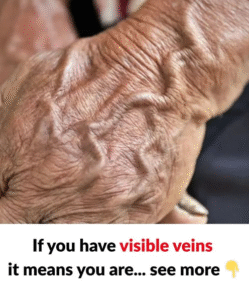As people age, it’s common to notice that their veins become more visible, especially on the hands, arms, and legs. This visibility isn’t necessarily a sign of disease or dysfunction, but rather a result of several natural changes that occur within the body over time. Understanding why this happens involves looking at the structure of the skin, the circulatory system, and how both are affected by the aging process.
One of the primary reasons veins become more visible with age is the thinning of the skin. Skin consists of multiple layers, including the epidermis (outer layer) and dermis (inner layer). As we age, the body produces less collagen and elastin—proteins that give the skin its structure and elasticity. This causes the skin to become thinner, more fragile, and less able to conceal underlying blood vessels. When the skin loses its plumpness and becomes more translucent, the veins beneath it naturally become more noticeable.
In addition to skin thinning, aging also causes a reduction in subcutaneous fat. This layer of fat, located just beneath the skin, provides padding and insulation. It helps to mask the veins in younger individuals. But as fat in this layer diminishes over time, the contours of veins become more pronounced. Hands, feet, and lower legs are particularly affected since they already have less fat to begin with, making changes there more obvious.
Another contributing factor is the change in vein structure and function. With age, veins can lose some of their elasticity, just like skin. This means they may stretch and enlarge, a process called venous dilation. When veins dilate, they come closer to the surface of the skin and appear more prominent. In some cases, this may lead to the development of varicose veins, especially in the legs. Varicose veins are swollen, twisted veins caused by weakened valves that allow blood to pool rather than flow efficiently back to the heart.
Circulatory efficiency also tends to decline with age. The valves in the veins, which help push blood upward against gravity (especially in the legs), can weaken. As a result, blood can accumulate in lower limbs, causing veins to swell and become more visible. This condition is more common in people who stand or sit for long periods and can be exacerbated by obesity, lack of movement, or a sedentary lifestyle.
Genetics also play a significant role in how visible a person’s veins become with age. Some people naturally have more prominent veins or thinner skin, making their veins visible even when they are young. In these individuals, age may simply enhance what is already noticeable. Additionally, fair-skinned individuals tend to show veins more clearly than those with darker skin due to the natural contrast between skin and vein color.
Sun exposure over time can also contribute to visible veins. Ultraviolet (UV) radiation breaks down collagen and elastin in the skin, accelerating the aging process. Chronic sun damage thins the skin, particularly on exposed areas like the backs of the hands and forearms, leading to increased vein visibility. This is why people who have spent a lot of time outdoors often notice prominent veins earlier in life.
Dehydration and physical activity can also make veins more noticeable temporarily. When the body is dehydrated, skin can lose its turgor (firmness), causing it to cling more closely to the structures underneath, including veins. Similarly, during and after exercise, veins can become engorged with blood as the cardiovascular system increases output to meet the body’s increased oxygen demand. This can make veins appear more prominent in the short term, especially in people with low body fat.
Hormonal changes also influence vein visibility. As estrogen levels decrease during menopause, women may experience changes in skin texture and thickness, contributing to more visible veins. Estrogen plays a role in maintaining skin elasticity and vascular tone, so its decline can exacerbate vein-related changes.
Certain medical conditions can also lead to more prominent veins, though these are less related to natural aging. Chronic venous insufficiency, vascular disease, or blood clots can make veins appear swollen and dark. While aging increases the risk for such conditions, their presence usually includes other symptoms like pain, swelling, or skin discoloration.
In most cases, visible veins with age are harmless and purely cosmetic. However, if veins suddenly become prominent, are painful, swollen, or accompanied by other symptoms such as redness, warmth, or sores, it may signal an underlying medical condition that should be evaluated by a healthcare provider.
For individuals concerned with the cosmetic appearance of visible veins, there are several treatment options. These include sclerotherapy (injections that collapse small veins), laser treatments, and minimally invasive vein removal procedures. Preventative measures like moisturizing, sun protection, regular exercise, maintaining a healthy weight, and elevating the legs can also help slow or reduce the appearance of aging-related vein visibility.
In summary, veins become more visible with age due to a combination of skin thinning, fat loss, vein enlargement, and declining vascular function. These changes are natural and expected as part of the aging process, though they may be more noticeable in some individuals depending on genetics, lifestyle, and environmental exposures. While they’re usually not cause for concern, significant or sudden changes in vein appearance should always be discussed with a healthcare professional to rule out any underlying health issues.


